Rob’s Recipe of the Week: An Alternative to Stir Fry for Onion
We’ve been getting spring onions in the share for a few weeks now, so I thought I would try something different to the usual stir fries and salads… The recipe this week is for spring onion dip! This should go well with courgette sticks, chips (oven baked from the new potatoes) and even fennel. Enjoy best served straight from the fridge, preferably after having a couple of days for the flavours to intensify.
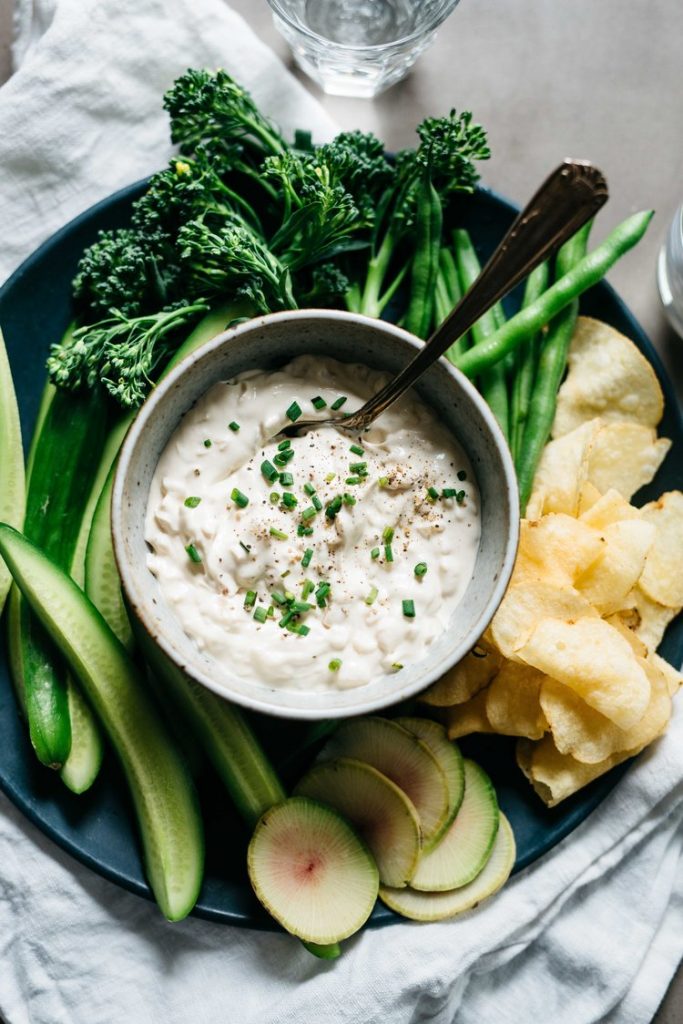
Spring onion dip
Ingredients:
3 tablespoons extra virgin olive oil
1 1/2 cups chopped spring onions
1 1/2 cups raw cashews, soaked overnight or at least 2 hours
fine sea salt
1/2 cup cream cheese (Tesco and Sainsburys both do good vegan alternatives)
1 tablespoon lemon juice
1 1/2 teaspoons apple cider vinegar
1 teaspoon tamari
1/4 teaspoon garlic powder
1/3 cup water, plus more if necessary
chives, for garnish
Method:
Heat a large pan over medium heat. Add 2 tablespoons of olive oil, the onion and a few pinches of salt then stir. Caramelise the onions over 10-12 minutes (stirring occasionally) then transfer to a plate and let cool
Meanwhile, add the cashews, cream cheese, lemon juice, vinegar, tamari, garlic powder, water and 1/2 teaspoon salt to the container of an upright blender (preferably high-speed). Blend on high, scraping down the sides until the dip is smooth and creamy
Taste and adjust the salt and/or lemon juice, as needed
Pour the dip into a bowl, and fold in the onions
Transfer to an airtight container and refrigerate for at least 3 hours, or overnight to really develop the onion flavor.
Rebecca’s Recipe of the Week: Spaghetti with Broad Beans and Marjoram
This immensely straightforward pasta dish demonstrates the results that can be achieved with very simple ingredients. The combination of fresh herbs, crunchy breadcrumbs and slippery, dark-green broad beans is delicious. A glass of rose or a pinot noir would be a very nice accompaniment.
Slipping the broad beans out of their little skins is a bit of a bother, but makes all the difference in the world to the delicacy of the finished dish. I imagine this would work very well with frozen broad beans, as well.
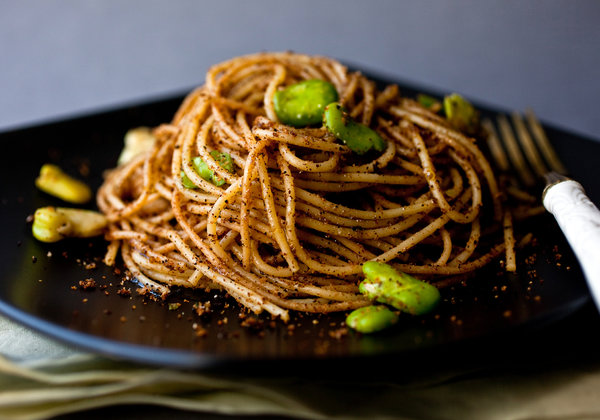
Spaghetti with Broad Beans and Marjoram
Serves 3-4
Ingredients
1kg broad beans, shelled
Salt
300g spaghetti
2 tablespoons olive oil
½ cup fresh bread crumbs, preferably whole wheat
3-4 tablespoons fresh marjoram leaves (to taste), roughly chopped
Freshly ground black pepper
Freshly grated Parmesan or pecorino (or a combination), for serving
Preparation
Bring a large pot of water to a rolling boil over high heat. Add the broad beans and cook for about 5 minutes, or until tender. Drain them, or, if you like, you can scoop the beans out of the water with a slotted spoon. This way you can use the same water to cook the pasta. Whichever approach you take, once the beans are out of the pan run them under some cold water to cool them down a little. Once they’re cool enough to handle, pop them out of their little papery skins.
Bring some more water to the boil, or use the same water. Salt generously, and then add the spaghetti. Cook over high heat, stirring occasionally so the pasta doesn’t stick together, until al dente, about 10 minutes.
Meanwhile, in a small skillet, heat the olive oil over medium heat, then add the bread crumbs, marjoram, salt and pepper. Cook, stirring, until crispy, three to four minutes. Turn off the heat, and set aside.
When the pasta is cooked al dente, remove ½ cup of the cooking water and then drain the pasta. Return the pasta to the pan, and add the broad beans and the cooking water. Return the pan to the heat and cook, stirring, for a minute or two, until the water is absorbed and the beans are warm. Stir in the bread crumb mixture and serve, passing the cheese at the table.
Recipe adapted from New York Times Cooking.
Rob’s Recipe of the Week: Beet and Kohlrabi soup
Welcome to Rob Liddle – the new addition to the weekly update, meaning we now have a recipe creator team!
Rob says: Next week’s share contains beetroot and kohlrabi, so I’ve chosen the soup recipe below (I’ve been looking for something new for lunches for a while!). The recipe makes 4 servings but can be scaled to suit share sizes.
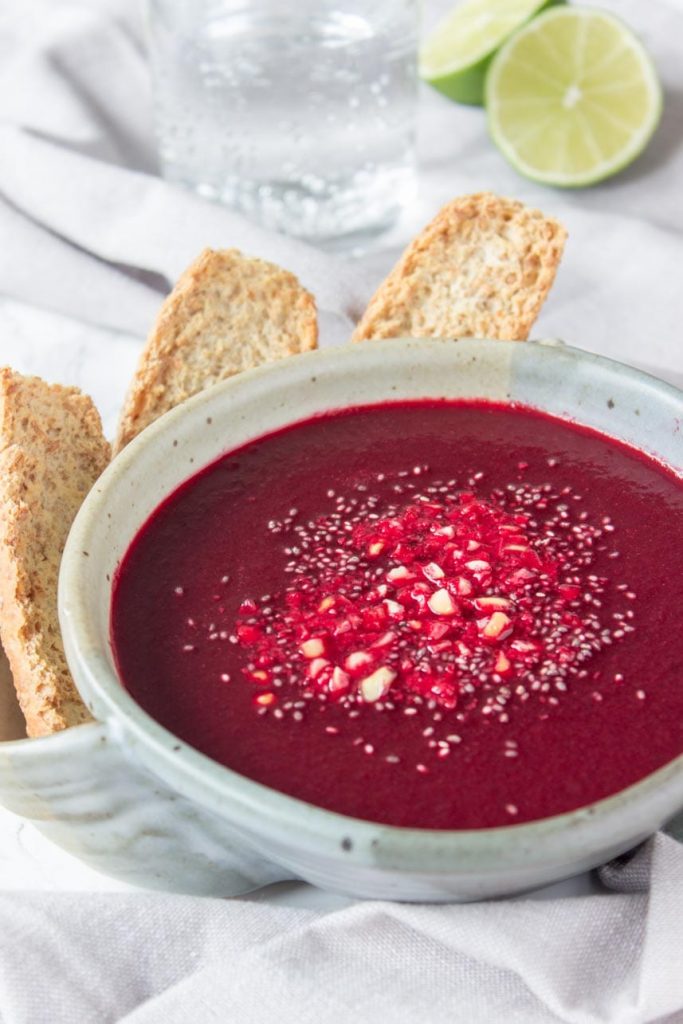
Ingredients
4 small-medium red beetroots diced (0.5cm pieces)
2 medium kohlrabi diced (0.5cm pieces)
1cm fresh ginger (peeled)
4 cups (~1L) water
1 teaspoon cinnamon powder
1 teaspoon turmeric powder
1/2 teaspoon ground cumin
1/4 teaspoon cayenne pepper
Pinch of ground cardamom
Salt to taste
Dash of lime juice to taste
2 tablespoons olive oil
Instructions
Put beetroot, kohlrabi, ginger, and water in a large pot. Bring to a boil over medium heat and then reduce heat to low. Cover and simmer for 25-30 minutes, until beets are fork tender.
Transfer soup to a blender. Add spices and lime juice. Purée on high until creamy and smooth. Return soup back to the pot. Add more water if soup is too thick.
Add olive oil and stir. Taste and adjust seasonings as needed, adding more salt to taste.
Serve hot or cold topped with some chia seeds, and chopped toasted peanuts.
Recipe and photo taken from: https://www.natalieshealth.com/beet-kohlrabi-soup/
Rebecca’s Recipe of the Week: Carrots with Pickled Raisins
Pickled raisins are very now, in case you didn’t know. This is a very good salad, in any case.
Carrot Salad with Yoghurt, Pickled Raisins and Nuts
Serves 2
Ingredients
2 tablespoons soft brown sugar (dark or light, as you prefer)
2 tablespoons apple cider vinegar
1 handful raisins (or sultanas)
200g carrots, peeled
1 tablespoon olive oil
Salt and pepper, to taste
2 tablespoons preserved lemon, chopped
1 handful pistachios or cashews, toasted briefly in a dry pan and roughly chopped
1 handful fresh coriander (or other herbs), roughly chopped
3 tablespoons yoghurt
Preparation
Combine the sugar and vinegar in a small bowl. Add the raisins and leave to soak for at least 10 minutes, or as long as you like. (I marinated mine for 4 days, at room temperature.) These are the pickled raisins.
Using a vegetable peeler, shave the carrots into thin curls into a bowl, or grate them coarsely.
Dress the carrots with the oil, salt and pepper, and preserved lemon. Mix in the raisins and soaking liquid, nuts, and herbs. Drizzle with the yoghurt and serve.
Recipe adapted from Abra Berens, Ruffage: A Practical Guide to Vegetables (2019).
Rebecca’s Recipe of the Week: Peas (and Salmon)
Peas cooked with onions and butter make an excellent dish to eat on their own. The peas in the share are sugar snaps, so you can eat the whole thing including the pod. Why not try cutting these up to add to this recipe? Add some pan-seared salmon fillets and you have an easy and very delicious meal.
(To pan-sear, dry the salmon carefully and then season liberally with salt. Heat a little neutral oil in a skillet, and when it is hot add the salmon, skin-side down. Press it into the pan with a fish so that it makes good contact with the heat. Cook, without moving the fish, for about 3 minutes, and then flip it over to cook the other side. Cook for an additional 1-4 minutes, depending on how cooked you like your fish.)
Peas with Parsley, Thyme, Butter and Onions
Serves 4 as part of a larger meal.
Ingredients
2 tablespoons neutral oil (rapeseed, sunflower seed etc.)
1 giant Canalside spring onion, thinly sliced (use the whole thing including the dark green leaves)
½ teaspoon salt
1/2 cup white wine
1 cup chicken stock
4 cups frozen (or fresh) peas (or pieces of sugar snap peas including the pods)
4 tablespoons butter
¾ cup fresh parsley, roughly chopped
5 springs of fresh thyme, roughly chopped
Preparation
Heat the oil in a large frying pan over medium heat. Add the sliced onion and the salt. Reduce the heat to low and cook until the onion is translucent and soft, but not brown. Add the wine and allow to reduce until almost completely dry.
Add the stock and bring to a boil. Add the peas and butter and cook until the stock has reduced, and the sauce is thick and silky with butter. Then add the parsley and thyme check for salt and pepper, and serve.
Recipe adapted from Abra Berens, Ruffage: A Practical Guide to Vegetables (2019).
Rebecca’s Recipe of the Week: Pumpkin Scones
‘These tasty savoury scones are best eaten warm with lashings of butter, or they can be served with prosciutto slices for a weekend brunch’, states Jacque Malouf. They’re also very good for dinner alongside an array of Canalside roasted vegetables.
Pumpkin, Cheese and Rosemary Scones
Makes about 8 scones
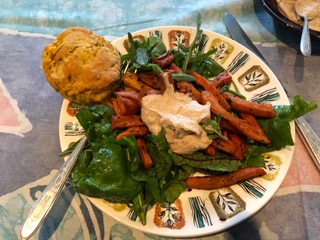
Ingredients
250g pumpkin or squash, peeled, de-seeded and cut into 2-inch chunks
1 tablespoon olive oil
Salt and pepper
250g self-raising flour
1 teaspoon bicarbonate of soda
½ teaspoon salt
60g cold butter, cut into small cubes
180ml buttermilk or yoghurt
1 tablespoon fresh rosemary leaves, finely chopped
100g sharp cheese (feta, cheddar, goat, as you prefer), cut into ½-inch cubes
Preparation
Preheat the oven to 200C. Place the squash or pumpkin on a baking tray and drizzle with olive oil, and then toss with salt and pepper. Roast for 30-50 minutes, or until the squash is tender and lightly caramelised. Set aside to cool. When cool, chop the squash into ¼-inch cubes.
Increase the oven temperature to 225C and butter a baking tray.
In a large mixing bowl combine the flour, bicarbonate of soda, ½ teaspoon salt, and a few grinds of black pepper. Rub in the butter until the mixture has an even consistency, like fine breadcrumbs.
Fold in the buttermilk, rosemary leaves, cheese, and cubed squash or pumpkin.
Knead gently in the bowl and then tip onto a floured board. Gently roll out to 1 inch thick. Cut into scones using a 2½-inch cutter.
Place the scones on the baking tray and bake for 12 minutes. Remove to a rack and eat warm or cold.
Recipe adapted from Jacqui Malouf, Breakfasts (2005).
Rebecca’s Recipe of the Week: Rye Bread with Radish Butter and Salmon Caviar
‘Peppery, earthy, salty: a good way to whet the appetite’, writes Diana Henry. These little nibbles make a splendid start to a dinner. The radish butter keeps in the freezer for ages. You could certainly use it under other smoked fish, or on its own as a sandwich butter.
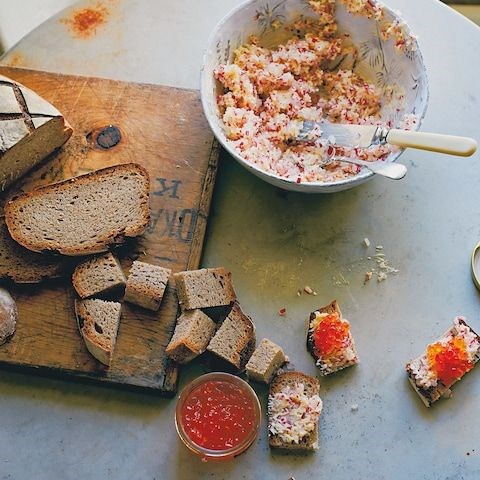
Rye Bread with Radish Butter and Salmon Caviar
Serves 4
Ingredients
125g radishes
60g unsalted butter, softened
¼ sea salt
Freshly-ground black pepper, to taste
½ loaf of dense rye bread
50g red lumpfish or salmon caviar
2 tablespoons fresh chives, minced
Preparation
Put the radishes in the bowl of a food processor and pulse 4-5 times until chopped into very fine dice. Transfer to a piece of muslin and wring out as much of the excess liquid as you can with your hands.
Tip into a bowl and add the butter, salt and pepper. Blend together with a rubber spatula until the mixture is well-combined.
Slice the bread into thin slices. Spread with radish butter and top with a spoonful of the lumpfish. Top with a sprinkling of fresh chives and a further grind of pepper.
Recipe adapted from Diana Henry, How to Eat a Peach (2018).
Rebecca’s Recipe of the Week: Spicy Coconut Cauliflower
Cumin-scented cauliflower, yellow from turmeric, cooks with Canalside chile and a subtle coconut-poppy seed glaze. The result is spicy, satisfying and beautiful. Eat it topped with toasted almonds, fresh coriander, yoghurt and a squeeze of lime. Yotam recommends serving with flatbread, but it’s pretty delicious just on its own.
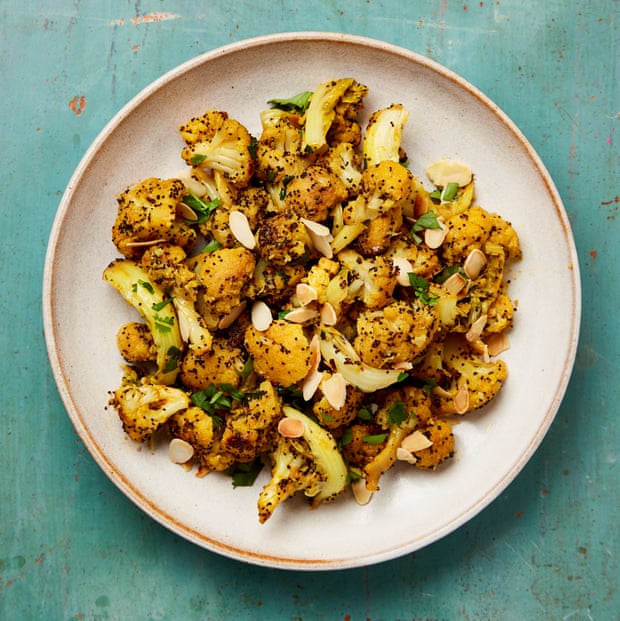
Poppy-Seed Cauliflower with Coconut
Serves 2
Ingredients
40g poppy seeds
60ml sunflower oil
½ – 1 Canalside dried red chile, de-seeded if desired, and shredded
1 teaspoon turmeric
1 teaspoon cumin seeds
2 garlic cloves, peeled and sliced fine
1 large cauliflower and leaves, broken into 4cm-sized florets, leaves shredded
150ml coconut milk (approx.)
To serve
1 handful fresh coriander, shredded
1 small handful flaked almonds, lightly toasted in a dry pan
plain yoghurt
1 lime, halved
Preparation
Put the poppy seeds in a small bowl. Pour over just enough boiling water to cover them. Leave them for half an hour, and then whiz them in a blender or food processor, or crush them in a mortar and pestle, so that they begin to break up a bit. Set aside.
Heat the oil over medium-high heat in a large sauté pan for which you have a lid. When it is hot add the chile, turmeric, cumin and garlic. Turn the heat to medium and sauté for 4 minutes, stirring often, until the garlic starts to brown and the mixture gives off a nice smell.
Add the cauliflower leaves and florets and toss with the spices. Stir for 2 minutes, until the cauliflower has turned an attractive yellow.
Add the coconut milk and the poppy seeds. Add enough coconut milk to make a little sauce, but not so much that it is soupy. Turn the heat down a little and cover. Cook for 4 more minutes, until the cauliflower has begun to soften.
Uncover and turn the heat up to medium-high. Cook for 8 more minutes, stirring regularly, until the cauliflower is tender and has begun to caramelise and the liquid has evaporated.
Serve topped with fresh coriander, toasted almonds, yoghurt and a squeeze of lime.
Recipe adapted from Yotam Ottolenghi, The Guardian, 16 Feb. 2019.
Rebecca’s Recipe of the Week: Carrot-Nut Porridge
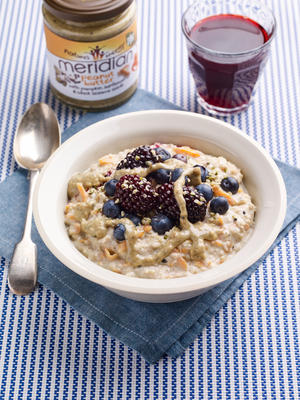
I was recently at an event where everyone was asked what they had for breakfast. 8 of the 10 people replied ‘porridge’. Clearly porridge is having a bit of a moment. Here is a surprising, satisfying and toothsome variant. Cooked with oat milk, shredded carrot becomes soft and sweet, blending perfectly with the oats to make a rich, thick breakfast. The peanut butter, berries and hemp hearts add further sweetness, depth and crunch.
Carrot-Nut Porridge
Serves 2
Ingredients
100g porridge oats
100g carrot, peeled and shredded
600ml oat milk
¼ teaspoon grated nutmeg
2cm vanilla pod
2 tablespoons crunchy peanut butter
Blueberries or blackberries, to serve (frozen are fine)
2 tablespoons hulled hemp seeds, to serve
2 tablespoons date syrup, mulberry syrup, maple syrup or honey, to serve (if desired)
Preparation
Place the oats, shredded carrot, oat milk, nutmeg and vanilla pod in a saucepan and bring slowly to a simmer. Simmer for 8-10 minutes, or until it’s thick and the carrot is soft. Stir in the peanut butter.
Divide into two serving bowls and top with berries and hemp seeds, and drizzle with syrup to taste.
Recipe adapted from Meridian Foods.
Ali’s Recipe of the Week: One for the Store-cupboard
Rebecca’s having a break this week and hopes to be back with another recipe next week.
With the cauliflower crop getting going, the moment may have arrived to do the first preserving of the year (that is, if you haven’t already made marmalade, perhaps using some delicious La Jimena seville oranges).
Piccalilli is as versatile as any savoury preserve in that you can flex the recipe according to what is available. Most piccalilli recipes call for courgettes, green beans, tomatoes, and other summer veg. However, if all you have is roots and PSB (purple sprouting broccoli) that combination will also make a perfectly good version of this tangy preserve. Luckily my book of preserves from the Women’s Institute can oblige with a suitably flexible recipe for any time of year! I’ve been know to make a version with cauliflower, onions (admittedly these are perhaps the two essential vegetables), carrot and swede!
Many piccalilli recipes call for the vegetables to be brined overnight, but this one breaks that rule, which simplifies the recipe and results in a delicious accompaniment for a ploughman’s lunch. And unlike chutneys which rely on evaporation of the liquid to thicken the preserve (which can sometimes take hours), as this one is thickened with flour it has a much shorter cooking time.
Accommodating Piccalilli from the W.I.
Makes about 2.7kg (6lb) = 6 average sized jam jars
Preparation time: 45 minutes
Cooking time: 30 minutes
Ingredients
1 large cauliflower, broken into florets
450g (1lb) pickling onions – if you’ve still got any little Canalside onions left, they’d be perfect!
1.4L (2 1/2 pints) white malt vinegar (apple cider vinegar also works well)
900g (2lb) mixed vegetables, diced or cut into 2.5cm (1 inch) lengths
2 fat cloves of garlic
450g (1lb) caster sugar
50g (2oz) dry mustard (i.e. mustard powder)
115g (4oz) plain white flour, sieved
25g (1oz) ground turmeric
1 tsp ground coriander
2 tsp salt
Preparation
In a large preserving pan, summer the cauliflower and onions in 1.1litres (2 pints) of the vinegar for 10 minutes.
Add the other vegetables, garlic and sugar and cook for a further 10 minutes.
Mix the mustard, flour. spices and salt with the remaining vinegar and add to the cooked vegetables, stirring all the time to prevent lumps from forming.
Stir well and simmer for a further 10 minutes.
Spoon into cooled and sterilised jars and cover with vinegar proof tops. Label and store for at least 2 weeks before using. It will keep for months (I think I’ve even kept it for more than a year) with the flavour improving and mellowing as it ages.
From ‘Best Kept Secrets of the Women’s Institute: Jams, Pickles and Preserves’ by Midge Thomas